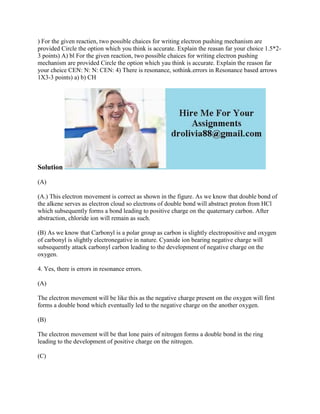) For the given reactien- two possible chaices for writing electron pu.docx
) For the given reactien, two possible chaices for writing electron pushing mechanism are provided Circle the option which you think is accurate. Explain the reasan far your choice 1.5*2-3 points) A) bl For the given reaction, two possible chaices for writing electron pushing mechanism are provided Circle the option which yau think is accurate. Explain the reason far your cheice CEN: N: N: CEN: 4) There is resonance, sothink.errors in Resonance based arrows 1X3-3 points) a) b) CH Solution (A) (A.) This electron movement is correct as shown in the figure. As we know that double bond of the alkene serves as electron cloud so electrons of double bond will abstract proton from HCl which subsequently forms a bond leading to positive charge on the quaternary carbon. After abstraction, chloride ion will remain as such. (B) As we know that Carbonyl is a polar group as carbon is slightly electropositive and oxygen of carbonyl is slightly electronegative in nature. Cyanide ion bearing negative charge will subsequently attack carbonyl carbon leading to the development of negative charge on the oxygen. 4. Yes, there is errors in resonance errors. (A) The electron movement will be like this as the negative charge present on the oxygen will first forms a double bond which eventually led to the negative charge on the another oxygen. (B) The electron movement will be that lone pairs of nitrogen forms a double bond in the ring leading to the development of positive charge on the nitrogen. (C) The cyanide ion attack the positively charged oxygen and the electron of the double bond were transferred to the carbon leading to the negative charge. .

Empfohlen
Empfohlen
Weitere ähnliche Inhalte
Ähnlich wie ) For the given reactien- two possible chaices for writing electron pu.docx
Ähnlich wie ) For the given reactien- two possible chaices for writing electron pu.docx (18)
Mehr von pjoseph6
Mehr von pjoseph6 (10)
Kürzlich hochgeladen
Kürzlich hochgeladen (20)
) For the given reactien- two possible chaices for writing electron pu.docx
- 1. ) For the given reactien, two possible chaices for writing electron pushing mechanism are provided Circle the option which you think is accurate. Explain the reasan far your choice 1.5*2- 3 points) A) bl For the given reaction, two possible chaices for writing electron pushing mechanism are provided Circle the option which yau think is accurate. Explain the reason far your cheice CEN: N: N: CEN: 4) There is resonance, sothink.errors in Resonance based arrows 1X3-3 points) a) b) CH Solution (A) (A.) This electron movement is correct as shown in the figure. As we know that double bond of the alkene serves as electron cloud so electrons of double bond will abstract proton from HCl which subsequently forms a bond leading to positive charge on the quaternary carbon. After abstraction, chloride ion will remain as such. (B) As we know that Carbonyl is a polar group as carbon is slightly electropositive and oxygen of carbonyl is slightly electronegative in nature. Cyanide ion bearing negative charge will subsequently attack carbonyl carbon leading to the development of negative charge on the oxygen. 4. Yes, there is errors in resonance errors. (A) The electron movement will be like this as the negative charge present on the oxygen will first forms a double bond which eventually led to the negative charge on the another oxygen. (B) The electron movement will be that lone pairs of nitrogen forms a double bond in the ring leading to the development of positive charge on the nitrogen. (C)
- 2. The cyanide ion attack the positively charged oxygen and the electron of the double bond were transferred to the carbon leading to the negative charge.